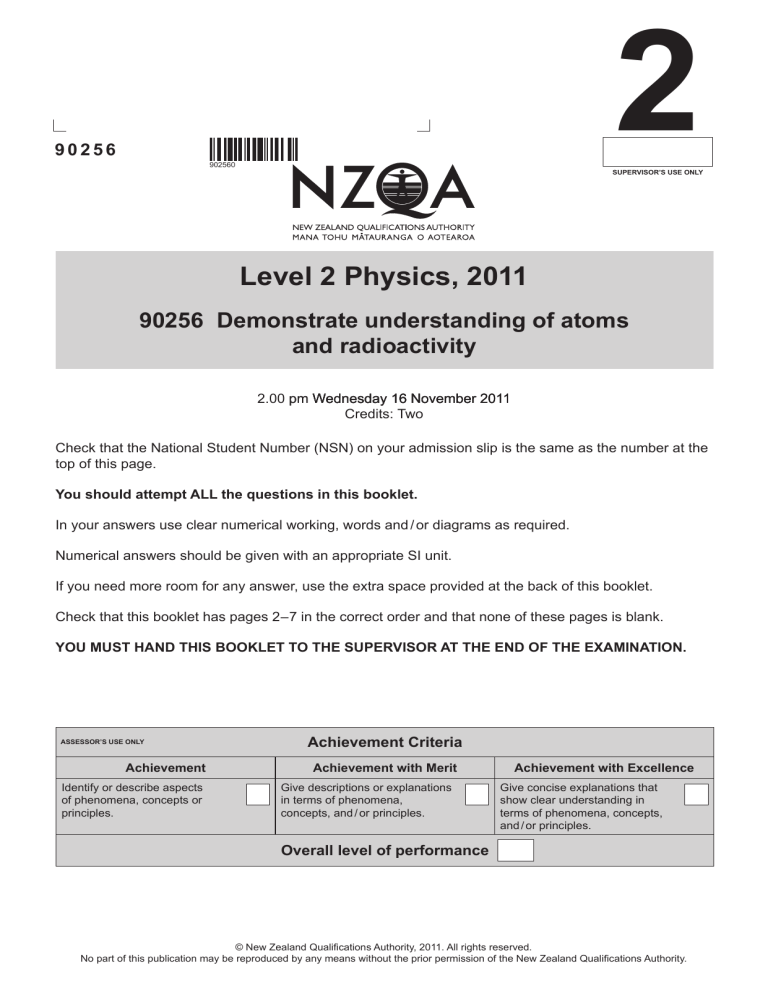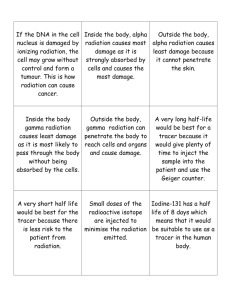
90256 2 902560 SUPERVISOR’S USE ONLY Level 2 Physics, 2011 90256 Demonstrate understanding of atoms and radioactivity 2.00 pm ����������������������������� Wednesday �������������������������� 16 November 2011 Credits: Two Check that the National Student Number (NSN) on your admission slip is the same as the number at the top of this page. You should attempt ALL the questions in this booklet. In your answers use clear numerical working, words and / or diagrams as required. Numerical answers should be given with an appropriate SI unit. If you need more room for any answer, use the extra space provided at the back of this booklet. Check that this booklet has pages 2 – 7 in the correct order and that none of these pages is blank. YOU MUST HAND THIS BOOKLET TO THE SUPERVISOR AT THE END OF THE EXAMINATION. ASSESSOR’S USE ONLY Achievement Identify or describe aspects of phenomena, concepts or principles. Achievement Criteria Achievement with Merit Give descriptions or explanations in terms of phenomena, concepts, and / or principles. Achievement with Excellence Give concise explanations that show clear understanding in terms of phenomena, concepts, and / or principles. Overall level of performance © New Zealand Qualifications Authority, 2011. All rights reserved. No part of this publication may be reproduced by any means without the prior permission of the New Zealand Qualifications Authority. 2 You are advised to spend 20 minutes answering the questions in this booklet. QUESTION ONE: MODELS OF THE ATOM At different times scientists have proposed various descriptions or models of the atom to match experimental evidence available. (a) The model that Thomson proposed was called the plum-pudding model. Describe this model. Geiger and Marsden performed a series of experiments under the direction of Ernest Rutherford which led to a new model of the atom. A model of the gold foil experiment is shown below. vacuum chamber radium source in a lead box Diagram is NOT to scale alpha particles gold foil zinc sulfide screen microscope (b) For each of the conclusions given below, state which observation from the experiment provides evidence that: (i) Most of the mass of the atom is concentrated in a tiny region which Rutherford called the nucleus. (ii) The nucleus is positively charged. Physics 90256, 2011 ASSESSOR’S USE ONLY 3 (c) Rutherford included several features in the experiment due to the characteristics of the alpha particles. Discuss the reason for each of the features below: (i) The source of the alpha particles is at the end of a narrow lead tube (ii) Vacuum chamber (iii) Zinc sulfide screen Physics 90256, 2011 ASSESSOR’S USE ONLY 4 QUESTION TWO: RADIOACTIVITY ASSESSOR’S USE ONLY Three sources of radiation are shown below. These sources emit radiation into a magnetic field that is directed into the page. (a) On the diagrams, draw arrows to show the path of each type of radiation as it passes through the magnetic field. Although in reality alpha and beta radiation have different speeds, for the purposes of this question, assume they have approximately the same speed. Alpha emitter Beta emitter Gamma emitter (b) Give detailed reasons for each of the shapes that you have drawn in the above diagram. (i) Alpha radiation: (ii) Beta radiation: (iii) Gamma radiation: Physics 90256, 2011 5 (c) Describe what each of alpha, beta and gamma radiation is, AND discuss what happens inside a nucleus when it produces each of the three types of radiation. In your answer, you will need to state what happens to the atomic (charge) number and the mass (nucleon) number. Alpha radiation: Beta radiation: Gamma radiation: Physics 90256, 2011 ASSESSOR’S USE ONLY 6 QUESTION THREE: RADIOACTIVE DECAY AND HALF LIFE (a) ASSESSOR’S USE ONLY Complete the equation showing alpha decay for radium-226. 226 88 Ra → Rn + ..... (b) Describe what is meant by the term, “half life of a radioactive nuclide”. (c) A Geiger counter is an instrument used to detect radiation. A Geiger counter detects 40 counts per second from a sample of iodine-131. The half life of iodine-131 is 8 days. (i) Using the axes given below, sketch a graph showing the count rate from the sample of iodine-131 over a period of 24 days. counts per second 40 30 20 10 0 (ii) 4 8 12 16 20 24 time (days) From the graph, deduce the activity of the sample of iodine-131 after 20 days. Physics 90256, 2011 7 QUESTION NUMBER Extra space if required. Write the question number(s) if applicable. Physics 90256, 2011 ASSESSOR’S USE ONLY 90256

